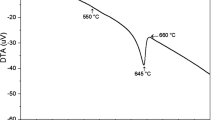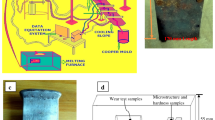Abstract
This study investigated the artificial aging process of TiB2/Al–5Cu composite, with a focus on the influence of TiB2 particles on the precipitation behavior of the composite. Additionally, a comparative analysis of the microhardness and tensile properties between the TiB2/Al–5Cu composite and the Al–5Cu alloy was conducted. X-ray Diffraction (XRD) analysis reveals that the TiB2/Al–5Cu composite consists of TiB2 and Al2Cu phases. The Scanning Electron Microscopy (SEM) imagery demonstrates a predominantly cellular crystal composition in the composite. Notably, as the aging time progresses, there’s an initial increase followed by a subsequent decrease in the gray grain boundaries of the composite. Transmission Electron Microscopy (TEM) images uncover the presence of needle-like θ phase, TiB2, and dislocations within the TiB2/Al–5Cu composite. The incorporation of TiB2 particles has emerged as a pivotal factor in significantly curtailing the artificial aging duration. With the peak hardness aging time determined at a mere 8 h, the TiB2/Al–5Cu composite showcases substantially higher hardness levels compared to the Al–5Cu base alloy. Remarkably, the optimum aging time for achieving the best mechanical properties in the composites is reduced from 20 to 8 h. Directly comparing the TiB2/Al–5Cu composite to the Al–5Cu alloy under peak aging conditions, notable enhancements in both yield strength (22%) and tensile strength (41%) are observed. Additionally, a slight increase in elongation is observed in the TiB2/Al–5Cu composite.













Similar content being viewed by others
References
A. Kordijazi, D. Weiss, S. Das, S. Behera, H.M. Roshan, P. Rohatgi, Effect of solidification time on microstructure, wettability, and corrosion properties of A205–T7 aluminum alloys. Int. J. Metalcast. 15, 2–12 (2021). https://doi.org/10.1007/s40962-020-00457-8
G.K. Sigworth, The corrosion of Al–Cu-based alloys and comments on the paper “Effect of solidification time on microstructure, wettability and corrosion properties of A205–T7 aluminum alloys” by Amir Kordijazi et al. Int. J. Metalcast. 15, 13–16 (2021). https://doi.org/10.1007/s40962-020-00475-6
V.S. Ayar, M.P. Sutaria, Comparative evaluation of ex situ and in situ method of fabricating aluminum/TiB2 composites. Int. J. Metalcast. 15, 1047–1056 (2021). https://doi.org/10.1007/s40962-020-00539-7
M.K. Hullur, D.M. Goudar, K. Venkateshwaralu, Sliding wear behaviour of in situ TiB2 reinforced hypoeutectic Al–Si alloy composites. Int. J. Metalcast. 17(2), 1179–1190 (2022). https://doi.org/10.1007/s40962-022-00847-0
R. Hu, R. Jiang, R. Li, Numerical simulation and casting experiments on particle dispersion in 2219 Al alloy by introducing Al–5Ti–1B and ultrasonic treatment. Int. J. Metalcast. (2023). https://doi.org/10.1007/s40962-023-01142-2
R.P. Barot, R.P. Desai, M.P. Sutaria, Effect of processing temperature on the synthesis of in situ AlSi5Cu3/TiB2 composites cast in metal mold: structural and mechanical characterizations. Int. J. Metalcast. (2023). https://doi.org/10.1007/s40962-023-01067-w
G.I. Eskin, D.G. Eskin, Production of natural and synthesized aluminum-based composite materials with the aid of ultrasonic (cavitation) treatment of the melt. Ultrason. Sonochem. 10(4–5), 297–301 (2003). https://doi.org/10.1016/S1350-4177(02)00158-X
Y. Xiong, W. Wang, R. Jiang, K. Lin, M. Shao, Mechanisms and FEM simulation of chip formation in orthogonal cutting in-situ TiB2/7050Al MMC. Materials 11(4), 1–19 (2018). https://doi.org/10.3390/ma11040606
Y. Zhang, N. Ma, H. Wang, Y. Le, X. Li, Damping capacity of in situ TiB2 particulates reinforced aluminium composites with Ti addition. Mater. Des. 28(2), 628–632 (2007). https://doi.org/10.1016/j.matdes.2005.07.015
K.L. Tee, L. Lu, M.O. Lai, In situ stir cast Al-TiB2 composite: processing and mechanical properties. Mater Sci Technol 17, 201–206 (2001)
L. Lü, M.O. Lai, Y. Su, H.L. Teo, C.F. Feng, In situ TiB2 reinforced Al alloy composites. Scr. Mater. 45, 1017–1023 (2001). https://doi.org/10.1016/S1359-6462(01)01128-9
L. Lu, M.O. Lai, F.L. Chen, Al-4 wt% Cu composite reinforced with in-situ TiB2 particles. Acta Mater. 45, 4297–4309 (1997). https://doi.org/10.1016/S1359-6454(97)00075-X
Z. Sadeghian, M.H. Enayati, P. Beiss, Characterisation of in situ Al-TiB2 nanocomposite powder synthesised by mechanical alloying. Powder Metall. 54, 46–49 (2011)
A.R. Kennedy, A.E. Karantzalis, S.M. Wyatt, The microstructure and mechanical properties of TiC and TiB2-reinforced cast metal matrix composites. J. Mater. Sci. 34, 933–940 (1999). https://doi.org/10.1023/A:1004519306186
S. Suresh, N. Shenbag, V. Moorthi, Aluminium-titanium diboride (Al-TiB2) metal matrix composites: challenges and opportunities. Proc Eng 38, 89–97 (2012). https://doi.org/10.1016/j.proeng.2012.06.013
P. Li, Y. Li, Y. Wu, G. Ma, X. Liu, Distribution of TiB2 particles and its effect on the mechanical properties of A390 alloy. Mater. Sci. Eng. A 546, 146–152 (2012). https://doi.org/10.1016/j.msea.2012.03.042
Y. Zhang, N. Ma, H. Wang, Effect of particulate/Al interface on the damping behavior of in situ TiB2 reinforced aluminium composite. Mater. Lett. 61, 3273–3275 (2007). https://doi.org/10.1016/j.matlet.2006.11.052
K. Lu, Composites offer the automotive industry an opportunity to reduce vehicle weight, improve performance. Mater. Sci. 328, 319–320 (2010). https://doi.org/10.1126/science.1182769
A. Macke, B.F. Schultz, P. Rohatgi, Metal matrix: composites offer the automotive industry an opportunity to reduce vehicle weight, improve performance. Adv. Mater. Process. 170, 19–23 (2012)
D.K. Koli, G. Agnihotri, R. Purohit, Advanced aluminium matrix composites: the critical need of automotive and aerospace engineering fields. Mater. Today Proc. 2, 3032–3041 (2015). https://doi.org/10.1016/j.matpr.2015.07.290
S.C. Tjong, Z.Y. Ma, Microstructural and mechanical characteristics of in situ metal matrix composites. Mater. Sci. Eng. R Rep. 29(3), 49–113 (2000). https://doi.org/10.1016/S0927-796X(00)00024-3
P. Ajay Kumar, P. Rohatgi, D. Weiss, 50 years of foundry-produced metal matrix composites and future opportunities. Int. J. Metalcast. 127, 37–59 (2019)
Z. Chen, T. Wang, Y. Zheng, Y. Zhao, H. Kang, L. Gao, Development of TiB2 reinforced aluminum foundry alloy based in situ composites—part I: an improved halide salt route to fabricate Al–5 wt%TiB2 master composite. Mater. Sci. Eng. A 605, 301–309 (2014). https://doi.org/10.1016/j.msea.2014.02.088
T. Wang, Z. Chen, Y. Zheng, Y. Zhao, H. Kang, L. Gao, Development of TiB2 reinforced aluminum foundry alloy based in situ composites—part II: enhancing the practical aluminum foundry alloys using the improved Al–5 wt%TiB2 master composite upon dilution. Mater. Sci. Eng. A 605, 22–32 (2014). https://doi.org/10.1016/j.msea.2014.03.021
Z.C. Liu, T. Zhu, Y.W. Jia, D.F. Song, N. Zhou, K.H. Zheng, Preparation of in-situ TiB2 reinforced aluminum matrix composites assisted by two steps of ultrasonic vibration. Mater. Res. Express 8, 1–13 (2021). https://doi.org/10.1088/2053-1591/abea5a
J.Y. Li, S.L. Lü, L. Chen, Q. Liao, W. Guo, S.S. Wu, Influence of squeeze casting pressure on nanoparticle distribution and mechanical properties of nano-SiCp/Al−Cu composites assisted with ultrasonic vibration. Trans. Nonferr. Met. Soc. China 33(7), 1977–1987 (2023). https://doi.org/10.1016/S1003-6326(23)66237-5
L.Y. Chen, J.Q. Xu, X.C. Li, Controlling phase growth during solidification by nanoparticles. Mater. Res. Lett. 3, 43–49 (2015). https://doi.org/10.1080/21663831.2014.956264
K. Wang, H.Y. Jiang, Y.W. Jia, H. Zhou, Q.D. Wang, B. Ye, W.J. Ding, Nanoparticle-inhibited growth of primary aluminum in Al–10Si alloys. Acta Mater. 103, 252–263 (2016). https://doi.org/10.1016/j.actamat.2015.10.005
N. Srivastava, G.P. Chaudhari, Microstructural evolution and mechanical behavior of ultrasonically synthesized Al6061-nano alumina composites. Mater. Sci. Eng. A 724, 199–207 (2018). https://doi.org/10.1016/j.msea.2018.03.092
M.T. Azhagan, M. Manoj, G.R. Jinu, Investigation of mechanical characterization, thermal behavior and dielectric properties on Al7075-TiB2 MMC fabricated using stir casting route. Int. J. Metalcast. (2022). https://doi.org/10.1007/s40962-022-00873-y
P.S. Tile, B. Thomas, Effect of load, sliding velocity, and reinforcements on wear characteristics of Al7075-based composite and nanocomposites fabricated by ultrasonic-assisted stir-casting technique. Int. J. Metalcast. (2023). https://doi.org/10.1007/s40962-023-01006-9
Y.F. Han, D. Shu, J. Wang, B.O. Sun, Microstructure and grain refining performance of Al-5Ti-1B master alloy prepared under high-intensity ultrasound. Mater. Sci. Eng. A 430, 326–331 (2006)
M. Estruga, L. Chen, H. Choi, X. Li, S. Jin, Ultrasonic-assisted synthesis of surface-clean TiB2 nanoparticles and their improved dispersion and capture in Al-matrix nanocomposites. ACS Appl. Mater. Interfaces 5, 8813–8819 (2013). https://doi.org/10.1021/am402719p
R. Du, Q. Gao, S. Wu, S. Lü, X. Zhou, Influence of TiB2 particles on aging behavior of in-situ TiB/Al–4.5Cu composites. Mater. Sci. Eng. A 721, 244–250 (2018)
S. Bahl, L.H. Xiong, L.F. Allard, R.A. Michi, J.D. Poplawsky, A.C. Chuang, D. Singh, T.R. Watkins, D.W. Shin, J.A. Haynes, A. Shyam, Aging behavior and strengthening mechanisms of coarsening resistant metastable θ’ precipitates in an Al–Cu alloy. Mater. Des. 198, 1–12 (2020). https://doi.org/10.1016/j.matdes.2020.109378
M. Mandal, R. Mitra, Study of dry sliding wear behavior of hot-rolled and mushy-state rolled Al–4.5Cu–5TiB2 in-situ composite with analysis of work hardening and subsurface microstructure-microtexture evolution using EBSD. Metall. Mater. Trans. A 50, 5356–5372 (2019). https://doi.org/10.1007/s11661-019-05406-7
H. Wang, H. Zhang, Z. Cui, Z. Chen, D. Chen, H. Wang, Investigation on the high-temperature ductility and fracture mechanisms of an in-situ particle reinforced Al matrix composite 7075Al/TiB2. Mater. Sci. Eng. A 764, 1–11 (2019). https://doi.org/10.1016/j.msea.2019.138263
Q. Yang, Y. Shen, J. Liu, L. Wang, Z. Chen, M.L. Wang, S.Y. Zhong, Y. Wu, H.W. Wang, Microstructure and mechanical response of TiB2/Al–Zn–Mg–Cu composites with more addition of Zn. J. Alloys Compd. 816, 1–11 (2020). https://doi.org/10.1016/j.jallcom.2019.152584
Q. Gao, S. Wu, S. LÜ, X. Duan, P. An, Preparation of in-situ 5vol% TiB2 particulate reinforced Al–4.5Cu alloy matrix composites assisted by improved mechanical stirring process. Mater. Des. 94, 79–86 (2016). https://doi.org/10.1016/j.matdes.2016.01.023
S. Mozammil, J. Karloopia, R. Verma, P.K. Jha, Effect of varying TiB2 reinforcement and its ageing behaviour on tensile and hardness properties of in-situ Al–4.5%Cu-xTiB2 composite. J. Alloys Compd. 793, 454–466 (2019). https://doi.org/10.1016/j.jallcom.2019.04.137
B.W. Zhao, Q. Yang, L. Wu, X.F. Li, M.L. Wang, H.W. Wang, Effects of nanosized particles on microstructure and mechanical properties of an aged in-situ TiB2/Al–Cu–Li composite. Mater. Sci. Eng. A Struct. Mater. Prop. Misrostruct. Process. 742, 573–583 (2019). https://doi.org/10.1016/j.msea.2018.11.032
S. Yang, R. Zhang, H. Liu, J. Li, H. Yan, Effect of La on microstructure and corrosion behavior of 10%TiB2(p)/Al–5%Cu composites. J. Market. Res. 9(4), 7047–7058 (2020). https://doi.org/10.1016/j.jmrt.2020.05.025
Y.W. Jia, S.C. Wang, D. Shu, Grain size prediction and investigation of 7055 aluminum alloy inoculated by Al–5Ti–1B master alloy. J. Alloys Compd. 821, 1–11 (2020). https://doi.org/10.1016/j.jallcom.2019.153504
W.B. Tu, J.G. Tang, L.H. Ma, X. Zhan, J.M. Ni, Study of natural aging behavior of Al–0.4Mg–1.0Si alloy with the addition of Sn at different solution heat treatment temperatures. J. Mater. Res. Technol. 28, 2845–2854 (2024). https://doi.org/10.1016/j.jmrt.2023.12.137
W.T. Chiu, T. Akama, M. Tahara, T. Inamura, K. Nakamura, H. Hosoda, Aging behaviors of the Al–Cu alloy via ultrasound-promoted thermal treatments. J. Market. Res. 28, 478–489 (2024). https://doi.org/10.1016/j.jmrt.2023.11.253
H.L. Peng, C. Jin, B.X. Dong, X.J. Zhou, Z. Wang, Y. Shao, H.Y. Yangd, F. Qiu, In-situ tailoring microstructure by directly synthesized TiC–TiB2 nanoparticles to achieve well-balanced strength and ductility in Al–Cu alloy. Mater. Sci. Eng. A 880, 145350 (2023). https://doi.org/10.1016/j.msea.2023.145350
H.S. Ren, Y.B. Liu, Q. Sun, P. Jin, Y.J. Tao, K.X. Kang, Q.H. Zhang, Q.J. Sun, Promoting strengthening and grain refinement of aluminum alloy during wire and arc additive manufacturing by adding TiB2 particles. Mater. Sci. Eng. A 888, 145805 (2023). https://doi.org/10.1016/j.msea.2023.145805
X.B. Zhang, J. Sun, M.L. Wang, Y.J. Zhang, N.H. Ma, H.W. Wang, Improvement of yttrium on the hot tearing susceptibility of 6TiB2/Al–5Cu composite. J. Rare Earths 32, 1335–1340 (2015). https://doi.org/10.1016/S1002-0721(14)60566-4
S.P. Ringer, B.T. Sofyan, K.S. Prasad, G.C. Quan, Precipitation reactions in Al–4.0Cu–0.3Mg (wt%) alloy. Acta Mater. 56, 2147–2160 (2008). https://doi.org/10.1016/j.actamat.2007.12.046
X. Shen, T. Li, J. Hong, H. Wang. Geng, Effects of TiB2 particles on microstructure and mechanical properties of an in-situ TiB2–Al–Cu–Li matrix composite. Mater. Sci. Eng. A 655, 265–268 (2016). https://doi.org/10.1016/j.msea.2015.12.104
T. Hong, X. Li, H. Wang, D. Chen, K. Wang, Effects of TiB2 particles on aging behavior of in-situ TiB2/Al–Cu–Mg composites. Mater. Sci. Eng. A 624, 110–117 (2015). https://doi.org/10.1016/j.msea.2014.11.072
K. Zhao, H. Kang, Y. Wu, M. Liu, E. Guo, Z. Chen, T. Wang, Manipulating the particle distribution of in situ TiB2p/Al composites via acoustic vibration and cooling rate. Mater. Lett. 262, 1–5 (2020). https://doi.org/10.1016/j.matlet.2019.127063
J.P. Lei, B.W. Lei, K. Zhang, G.L. Liu, Y.Y. Liu, Grain-refining mechanism in hypereutectic Al–20Si alloy with minor Sr–Sc–La and ultrasonic vibration treatment. Heliyon 9(9), 1–9 (2023). https://doi.org/10.1016/j.heliyon.2023.e19272
Acknowledgements
The authors express their gratitude for the financial support from the Natural Science Foundation of China (No. 52204385) and the Natural Science Special Foundation of Guizhou University (No.202330).
Author information
Authors and Affiliations
Corresponding author
Additional information
Publisher's Note
Springer Nature remains neutral with regard to jurisdictional claims in published maps and institutional affiliations.
Rights and permissions
Springer Nature or its licensor (e.g. a society or other partner) holds exclusive rights to this article under a publishing agreement with the author(s) or other rightsholder(s); author self-archiving of the accepted manuscript version of this article is solely governed by the terms of such publishing agreement and applicable law.
About this article
Cite this article
Jia, Y., Shang, X., YunChe et al. The Influence of TiB2 Particles on the Artificial Aging Behavior of TiB2/Al–5Cu Composite. Inter Metalcast (2024). https://doi.org/10.1007/s40962-024-01316-6
Received:
Accepted:
Published:
DOI: https://doi.org/10.1007/s40962-024-01316-6




